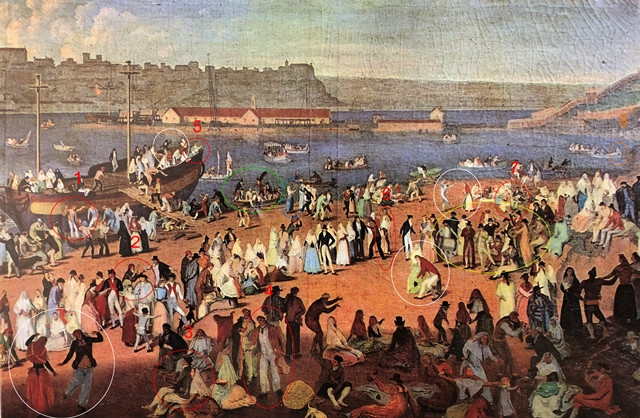
News
Pasqual Calbó and the music in art in Menorca
During the course of 2017, an exhibition and various different events were held to mark the bicentenary of the death of Pasqual Calbó i Caldés (1752-1817), a Minorcan painter considered to be one of the best at depicting the island’s history. He studied under Italian painter Giuseppe Chiesa (1720-1789), who settled in Minorca, and it was the latter who encouraged Calbó i Caldés to travel to Italy to complete his studies (in Venice and Rome). Later, Calbó i Caldés went to Vienna, where he was appointed head draughtsman at the city’s imperial gallery and, subsequently, head court painter for the empress and the gallery’s director.
In this blog post, a short outline will be given of a much longer article soon to be published, we hope, containing an analysis of Minorca’s 19th and early 20th century musical iconography through the historical and musical context of the time. In the meantime, we will concentrate on describing the instruments and scenes shown in this painting.
In about 1802, Calbó drew a sketch that would form the basis of the painting that we will go on to describe. According to our consulted sources, it has various different titles: Festa de carnaval a s’Altra Banda (Carnival Festivities on the Other Side) or Festa campestre en el Riu Pla (Rural Festivities at River Pla) or Festa en el Riu Pla (Festivities at River Pla). The said “122 x 80 cm painting from the Montoto collection in Barcelona depicts a typical scene, with people eating and drinking, musicians playing guitars and bandurrias (a type of lute), fandango dancers, and people coming ashore, with the bank of River Pla as the general setting and city of Mahon in the background.” (Andreu, 1986).
In this painting, two distinct scenes can be identified: the group of people on the boat–where celebrations are also being held–and the area around it, and the people who are already on land, eating, drinking, playing music or dancing. A second distinction between these two scenes can also be made: the people’s clothes, identifying them as being from the popular or wealthier classes. In this second case, we cannot make out whether they are actually aristocrats, but they are definitely well-off and fashionably dressed, mixed in with people from the lower classes. There is also a third distinction: the music and dancing.
We begin by analysing the scenes from left to right where, first of all, guitars and a mandolin can be seen, marked in red circles and an orange one, followed by a tambourine (in a blue circle) and the big main group (circled in yellow).
- A man in a traditional hat and loose clothing can be seen, carrying a guitar in his right hand and holding it by the neck. He is in a boat which people are landing from, and both his arms are raised, as if greeting people familiar to him.
- A man in a traditional hat can be seen, carrying a large guitar under his right arm (possibly of a type known as a guitarrón), while with his left hand he seems to be asking a middle or upper-class man in a hat for money.
- A man can be seen sitting on a stone, wearing a French-style hat (with a wide turned-down brim). He is playing the guitar, while a couple dance just in front of him.
- A man with a jacket over his shoulders and traditional hat can be seen, carrying a guitar in his left hand. He is talking to another man.
- A man can be seen in the boat, playing the guitar. He also has two dancers in front of him and they might be playing castanets, although it is hard to make out (and so these instruments will not be taken into account).
- A woman can be seen wearing a shawl and carrying a basket with food or an amphora on her head, possibly containing something to drink. She is holding a guitar by the neck in her right hand. She is the only woman with a guitar.
- Two men can be seen wearing traditional hats, sitting and playing the guitar. They also have a couple of dancers a few metres away from them.
- In the orange circle, a man with his feet outside the boat can just be made out, wearing a hat and loose clothing. He seems to be carrying a mandolin by the round shape of its body.
The green circle is perhaps the most intriguing or amusing, since two violinists and a cello player can be seen in a boat. Given the period, this last instrument might be a violone. They are dressed in frock coats and tight trousers.
In the blue circle, there is a woman playing a tambourine and perhaps (again this is a hypothesis because it is hard to make out) there is someone accompanying her with castanets.
Finally, in the yellow circle, there is a large group of wind and percussion players. They are wearing frock coats and tight trousers. As stated previously, there is:
- A dulcian, although Josep Borràs considers that its shorter bell is more typical of the former
- Two baroque horns.
- Four bagpipes (which could be oboes) although the shape of the bell and length is more reminiscent of a bagpipe.
- A flute.
- Some small cymbals.
- A big double-membrane bass drum.
As we have already said, an in-depth analysis of this painting and others from the period is in the pipeline and our hope is that it will soon be published so that a better insight can be gained into Minorca’s musical iconography.


